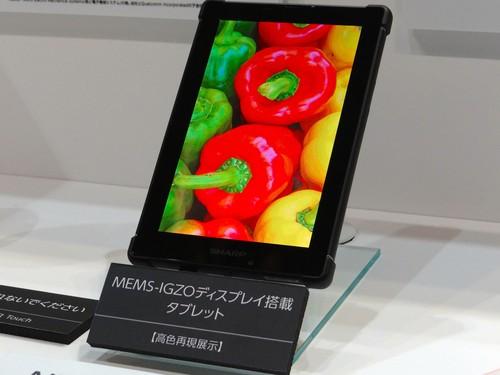
Sharp's prototype tablet computer with a 7-inch MEMS display is on show at Ceatec in Japan on October 6, 2014.
Sharp is close to commercializing its first product that uses a MEMS display -- a new type of flat-panel display that boasts deeper and richer colors than traditional LCD screens and lower power consumption.
The screen was developed over the last three years with Qualcomm subsidiary Pixtronix and Sharp hopes it will one day replace LCD screens in portable devices.
That's a big deal for both Sharp and Qualcomm. Sharp is a market leader in LCD and has pioneered numerous innovations in the technology while Qualcomm has been trying to popularize MEMS for several years. Qualcomm has fitted a MEMS display in its prototype Toq smartwatch.
The way MEMS displays control the light from each pixel is fundamentally different than the way LCD displays work.
LCD screens are built on a bright, white backlight that sits at the rear of the screen. Each pixel is divided into red, green and blue subpixels with color filters. Current applied to the liquid crystal in front of each of those filters allows or blocks transmission of light of that color.
In a MEMS screen, there are no red, green or blue subpixels. Instead, a tiny electro-mechanical shutter allows or blocks light transmission through each pixel. Color is provided by the backlight, which cycles rapidly through red, green and blue. The shutters are synchronized to the backlight, moving open and shut in as little as 100 microseconds to let through light of the appropriate color.
This arrangement means a much wider range of colors can be displayed by the MEMS screen, said Akira Imai , general manager of development and strategy at Sharp's display device development division. Whereas some advanced LCD screens manage to reproduce up to 90 percent of the range of colors defined by the NTSC television color standard, its gamut, the MEMS screens push past the limit by around 20 percent.
A prototype 7-inch MEMS panel on display at the Ceatec exhibition in Chiba, just east of Tokyo, showed vividly deeper colors than would be typical on an LCD screen. The panel, which will be used in the forthcoming Sharp tablet, has a 1280 by 800 pixel resolution.
As a first step, Sharp plans to put on sale a tablet computer featuring a MEMS screen in Japan in the first half of 2015, it said Monday. The tablet will be aimed at business users from which Sharp will solicit feedback ahead of planned mass production in 2017, it said.
The tablet will run Google's Android 4.4, be based on a Qualcomm Snapdragon processor and have built-in 4G wireless connectivity, said Sharp. A price or launch date was not announced.
Martyn Williams covers mobile telecoms, Silicon Valley and general technology breaking news for The IDG News Service. Follow Martyn on Twitter at @martyn_williams. Martyn's e-mail address is martyn_williams@idg.com
Join the CIO New Zealand group on LinkedIn. The group is open to CIOs, IT Directors, COOs, CTOs and senior IT managers.


